
Gastronomy
Dominican cuisine is multicultural, an aboriginal, Spanish, and African legacy of five centuries that continues to evolve with the contribution of other ethnic groups and the new generations of creative chefs that enhance its identity. Innovations and fusions, with their combination of ingredients “achieve an explosion of flavors for all tastes,” according to “Lo Dominicano / All Things Dominican,” a book by the Global Foundation for Democracy and Development (GFDD).
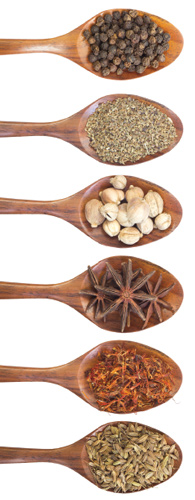 The basis of the Dominican cuisine is the sofrito, a seasoning made of garlic, onion, chilli, oregano, cilantro, salt, vinegar, bija or tomato sauce, which are simmered slowly until they release their flavors and the fragrance of their scents.
The basis of the Dominican cuisine is the sofrito, a seasoning made of garlic, onion, chilli, oregano, cilantro, salt, vinegar, bija or tomato sauce, which are simmered slowly until they release their flavors and the fragrance of their scents.
That basis is one of the similarities that Dominican cuisine shares with other Caribbean islands, in addition to the consumption of cassava, yautia, sweet potato, yam, corn, bananas, pumpkin, fruit bread, rice and beans.
Did you know? “La Bandera” (the flag) is the most emblematic everyday meal dish in the Dominican Republic, consisting of white rice, beans (over rice) and meat servings, accompanied by some salad and fried ripe plantains.
We invite you to learn more about Dominican cuisine, including some of the most recognized emblematic recipes, in the publication “Lo Dominicano / All things Dominican” of the Global Foundation for Democracy and Development (GFDD), which is available on Amazon here.
Typical Cuisine
An early Creole culinary fusion was sancocho, a broth that combined the meats of beef, pork, and chicken of the Spanish diet, with yam and yautia brought from Africa, and the bananas from Asia, along with corn, chili and native herbs.This dense tuber broth, which contains in its richest version up to seven meats, has been declared by consensus the “most representative and popular” dish of the Dominican cuisine.Sancocho has been eaten since the colonial era and, for centuries, was the main food of the Dominican peasants. Nowadays, it is a dish for special occasions.It has been a long time since the combination of rice with beans, meat, green salad and fried plantain or cassava has dominated lunchtime, a dish so associated to the Dominican identity that it is called “la bandera dominicana” (the Dominican flag).
Did you know? Casabe is a dry, thin and circular bread that is obtained after a long and painstaking process of grating, pressing and drying cassava to extract the juice. Then, it is grinded to obtain a fine flour from which the casabe is made.
As rice is a basic component in the national diet and in the generation of agricultural wealth, its importance has become such that the authorities consider it a “political crop.”
No surprise there. Statistics indicate that each Dominican consumes between 45 and 50 kilograms of rice per year.
There are other typical rice-based dishes: the asopao, a soup of thick rice to which chicken, pork chops or seafood is added, along with auyamas and potatoes; moro of rice and beans, and locrio, a combination of rice with ham, chicken or shrimp, a distant relative of the Spanish paella.
On the heels of rice is the banana,” one of the most consumed and preferred foods, which is prepared in a myriad of ways” (“Lo Dominicano,” GFDD). It is estimated that each Dominican eats about 300 units of bananas a year.
Bananas have given rise to three classics of the Creole cuisine: mangú, tostones and mofongo, of incomparable flavor.
Mangú encebollado (cooked with onions), with fried eggs, ham or salami, is a typical breakfast, and, sometimes, also dinner. Tostones or fried plantains cut into slices accompany all dishes, the “pica pollo,” pork, fish, rice, and are served in “picaderas” (snacks). Mofongo is made with roasted or fried plantains, mashed with garlic and crispy pork rinds. Culinary experts consider it an adaptation of the African fufú.
Other traditional side dishes of the middle class are arepitas or fried cassava or corn, salads, and eggplant, potato, banana and cassava pies.
It is also worth mentioning the Taíno cassava, derived from cassava, which is evident still today in the Dominican table in varieties unthinkable to the natives. The crispy cassava cakes that accompany the “picaderas” have different sizes, shapes and flavors.
Sweetly Dominican
In terms of high quality desserts, Dominican baking is well positioned. Many bakeries preparing exquisite pastries are thriving, fusing local and foreign ingredients. De la Casa Pastelería, La Cuchara de Madera, Pastelería del Jardín, Bondelic, Fresco del Horno, Españolerías, La Dolcerie, Panavi, among others, stand out in the capital city.
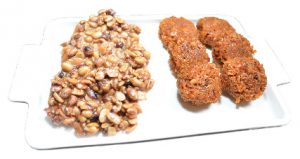 The traditional desserts of the popular fare are flan, rice pudding, majarete, based on grated corn, coconut milk, sugar, vanilla and cinnamon; sweets made with milk, soft coconut, pineapple with sweet potato, and coconut; coconut “jalao;” tamarind balls; figs with tender coconut; milk and oranges; cashews; guava with fresh cheese, and canquiñas, multicolored and chewy coconut sticks.
The traditional desserts of the popular fare are flan, rice pudding, majarete, based on grated corn, coconut milk, sugar, vanilla and cinnamon; sweets made with milk, soft coconut, pineapple with sweet potato, and coconut; coconut “jalao;” tamarind balls; figs with tender coconut; milk and oranges; cashews; guava with fresh cheese, and canquiñas, multicolored and chewy coconut sticks.
Did you know? Churumbeles, also known as memelos or cacos, are well-known little balls stuffed with grated coconut in syrup, covered in red caramel. They can be found in the streets and at Dominican beaches, on a tray on the shoulders of their vendors.Equally important are the sweet arepas made of corn, the sweet beans, and the sponge cakes and puddings that adorn the celebrations and cheer the palates, next to salty delicacies, such as cakes filled with beef and raisins, or cheese and leeks, and the miniature quipes, the chicken croquettes and the cassava empanadas, called catibías.
Did you know? Mocana cookies are crispy cookies made from ginger and colored ssuspiros (beaten egg white), made in the city of Moca, located in the province of Espaillat. They have been in the Dominican market for more than 100 years and have become a nostalgic product at local pastry shops.
Regional Dishes
Although the consumption of traditional dishes is nearly common place in the entire country, each region has its own culinary expressions that depend on its environment. Young goat (kid) or goat meat is one of the favorites in the South, where Chenchén and El Chacá are also eaten, both based on corn, which are typical of Haiti, and possibly native to West Africa.Kid with oregano and hot peppers is popular in the Northwest, and in the Cibao region, as well as the “pieces” of plantains, bananas and boiled rulos (shorter, thicker variety of plantain), accompanied by smoked herring or fried beef, as well as pork roasted outdoors at the stake with firewood in iron cookers. Among the preferences of the Eastern region are fish and moro with coconut, corn flour with molondrones, and yaniqueques, a crunchy flour pastry.
Ethnic Contributions ‘gone native’
In addition to its Columbian-era legacy, Dominican cuisine is nourished by the contribution of other immigrants, such as the Lebanese, the Syrians and the Palestinians (“Lo Dominicano,” GFDD.)Lebanese kibbe and tabouleh have reappeared in the country with the names of quipe and tipile, two dishes that are frequent found on the Dominican table, as well as the stuffed meat, rice and vegetables wrapped in grape leaves or cabbage, which the natives have named “niños envueltos” (wrapped children). Cheeses with oregano have a preferential place, along with eggplant and Arab-style meatballs, as well as the empanadas stuffed with spinach and other vegetables seasoned with distinctive ingredients: onion, lime, cinnamon, pepper and malagueta.The national cuisine has also assimilated the sweets from the Middle East: deditos de novia (bride’s fingers), baclava, polvorones (shortbread) and other sweets based on white flour, sesame seeds, nuts, honey and almonds.
The Afro-Caribbean
Dominican gastronomy has also been enriched by the culinary tradition of the “cocolos,” immigrants who came from other Caribbean territories to different parts of the national territory, mainly to the port areas of Puerto Plata, San Pedro de Macorís, Sánchez, Samaná and Montecristi.
The cocolos and their descendants contributed their cuisine based on wheat and corn flour, coconut and fish, and the appreciation for white yautía and coconut yautía. Fried yaniqueques, made of wheat flour, are among the most widespread and assimilated dishes, as well as the domplines or boiled flour buns, accompanied with cod or salami in a cheese sauce. Also, fish with coconut milk, oregano and garlic, as well as the “conconetes,” which are made from wheat and coconut flour.
The unique Guavaberry drink, a liqueur prepared with bayberry berries, rum, dried fruits, cinnamon, ginger and vanilla, originally comes from them and is very popular in the province of San Pedro de Macorís.
In the Caribbean island of St. Martin, the wild myrtle is known as guavaberry. They make an infusion with those berries, rum, and sugar and put the mix in a bottle. It is a Christmas tradition that is preserved from generation to generation.
“Calalu” is part of the cocola tradition, a green soup of molondrones and vegetable leaves, a national dish of Trinidad and Tobago that exists in the Caribbean islands in different versions and with different names. The Calalú, callaloo, or quimbombó, evokes the Gumbo of the southern creoles of Louisiana, United States. Its origin is traced to the rituals of the African Yoruba religion.
Calalú-gombo is a popular food in Haiti, particularly at wakes, and it is offered as food to the Orisha Chango or Sangó god in the Santería rites in Cuba, which blends it together with San Marcos and Santa Bárbara (cocina del Caribe, mailxmail.com).
It is a typical dish in Paria, Venezuela, in the Caribbean coast of Colombia, in Jamaica, Puerto Rico and throughout all the Lesser Antilles.
Freed African-Americans who came to the island in the 19th century, before the creation of the Republic, also enriched the culinary heritage with dishes such as grits, corn flour that they ate at breakfast, and roast pork, chicken and turkey; cornbread and sweet potato bread, chocolate and ginger beer (Martha Ellen Davis, “Asentamiento y vida económica de los inmigrantes afroamericanos de Samaná,” Bulletin of the General Archive of the Nation, volume XXXII number 119).
European cuisine has left deep traces in the Dominicans eating habits. Spanish dishes are preserved in the form of potato omelets with eggs and ham; chickpea stew with bacon; black pudding; cod with potatoes; and, when it comes to sweets, the nougat, marzipan, custard, donuts, punches and rice pudding.
The contribution of Italian pasta dishes is more recent but of great impact. Dominicans frequently consume pasta in all its varieties, fillings and sauces: cannelloni, elbows, spaghetti, fettuccini, noodles, linguini, gnocchi, macaroni and ravioli. Lasagna has been adopted as a staple dish, with numerous Creole versions.
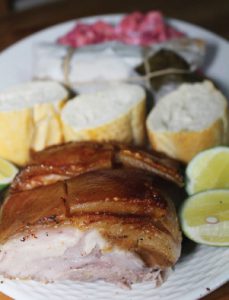 Christmas Eve Dishes
Christmas Eve Dishes
Lasagna has become so conspicuous that it even appears in the traditional Christmas dinner, although the three musketeers on December 24th are still pork, pasteles en hojas (tamales) and Russian salad (made of potatoes, carrots and beets). Additionally, telera, a long loaf of soft bread, and optionally, rice and pigeon peas or a ripe plantain pie.
Round cakes filled with meat, eggs and raisins, and semicircular empanadas filled with chicken, beef, pork, cheese and vegetables are popular party foods.
Nougat, polvorones and biscuits with dried fruits, as well as grapes, pears and apples for dessert. The traditional Christmas drink is the cream and rum punch, as well as cider and wine.
Easter
The quintessential Easter dish is sweet beans, made with red beans, coconut milk, sugar, cloves, cinnamon, sweet potatoes, raisins and milk cookies, which begin to be served on Palm Sunday. It is a mandatory dessert after lunch, which restricts meat intake during Lent and prioritizes fish, cod, tuna, rice, stewed pigeon peas, green salads and vegetables. In the South, where corn is abundant, it is more traditional to consume chacá as a dessert during the season and throughout the year.
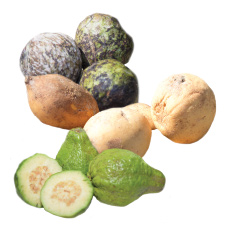 The Fruits
The Fruits
Nispero, zapote, pineapple, papaya, caimito, guanábana, mamón, jobo, guava, jagua, anón, cherimoya and granadillo are fruits native to the island. Mango, orange, banana, chinola, cajuil, and fig are exogenous fruits. They are consumed fresh and they are used as the base of sweets and typical juices in the national gastronomy.
The Beverages
Nutritious and tasty, fruit juices energize, refresh and are available to everyone at bars, cafes and restaurants. They are locally called “batidas.” Among those preferred are the ones made of papaya, zapote, guava, pineapple, granadillo and mango; they are almost always combined with milk. The most typical of all is probably “morir soñando” (to die dreaming), a mixture of orange, milk and sugar with ice that Dominicans drink from childhood.
Other beverages worthy to be tasted are fermented mabí de bejuco de indio, cane juice, pineapple guarapo extracted from the rind of that fruit, oatmeal with pineapple juice, and the frío-frío, a fruit syrup on shaved ice.
A typical homemade drink is the “damajuana” or “mamajuana,” a bottle that curanderos (healers) prepare with herbs and medicinal roots, honey and spices.
As for hot drinks, Dominicans have the tradition of drinking coffee in the morning and in the afternoon; cinnamon and ginger tea on cold days, and chocolate with water or milk at dinner and breakfast.
The quintessential alcoholic drinks are rum and beer, and the country has an elaboration tradition that goes back to the 19th century. Less noble are the preparations made of sugar cane liquor of high alcohol content, such as the Triculi, common in the countryside and towns.
The New Cuisine
Plantain, cassava, sweet potato and yautía, humble foods of the popular table, entered the haute cuisine thanks to a generation of chefs who are revolutionizing the Dominican cuisine. They use fruits in new and creative ways, and give traditional dishes of meat, fish and rice experimental twists and turns.
The new gastronomy is elegant, creative, impeccable in presentation, and tempts the palate with its unexpected fusions and flavors.
Chef Tita -Inés Báez Nin- is one of those who reinvents the ancestral dishes from her haute cuisine and signature cuisine restaurant, Travesías, and she does it with vision and philosophy. She does not work only because of the creative impulse to satisfy her clientele. She does it so that her kitchen becomes an “agent for change,” a source of income for the poor, elevating it to the category of country brand gastronomy (Arturo A. Guisarre, Listín Diario).
For this reason, in her work she deals with artisan producers, farmers and fishermen, highlighting stories and geographical locations in her dishes:
- Fresh oysters, from Cabrera, with lemon coconut foam from Samaná; crab with cilantro oil, bija mayonnaise and crispy banana. Also, sauce made with native cherries in a corn duo.
- Guanabana salad, a mixture of greens from Constanza, with vinaigrette of that fruit and grilled chicken with toasted sesame seeds.
- Sancocho Bayahíbe made with fish and shellfish from the Dominican coast, on a base of auyama cream.
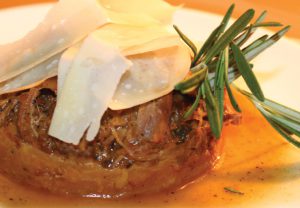 Her dishes revive the use of the anón, bija and mamón, the fruit bread, the guava, the mamajuana, the jobo and the guavaberry. Additional samples of her cuisine are the sweet white beans crème brulée and white chocolate, and “fresco de Guatapaná al limón de nuestra costa,” one of the Taíno heritage.
Her dishes revive the use of the anón, bija and mamón, the fruit bread, the guava, the mamajuana, the jobo and the guavaberry. Additional samples of her cuisine are the sweet white beans crème brulée and white chocolate, and “fresco de Guatapaná al limón de nuestra costa,” one of the Taíno heritage.
“La Chefa,” Rosa María Gómez, is another creative representative of the local haute cuisine. She makes new combinations and creates amazing flavors with daily consumption foods.
La Chefa has prepared side dishes with popular “supplies,” such as curry mashed sweet potato, white yautía and queso de hoja (artisan cheese) souffle, and her asopao of pigeon peas with coconut shrimp.
Hers is a cuisine with real Dominican aromas and flavors, sometimes fused with ingredients from other places, which she has exported to other countries:
- Chicken breasts stuffed with ripe plantain and prosciutto, with chinola sauce.
- Chicken legs stuffed with plum and cranberries, in pineapple sauce.
- Pork wraps, stuffed with plum, with chinola sauce and ginger.
Casa Caribe, the culinary laboratory directed by La Chefa, has developed a score of innovative dishes that it has exported to other latitudes. One of her latest presentations was at the Bahia Marina hotel, on Culebra Island, in Puerto Rico.
Her work “La nueva cocina dominicana de la chefa” includes recipes of her own creation as well as her culinary research, which trace the food traditions of the natives, the Europeans and the Africans.
Another ambassador of the Dominican gastronomy is Chef Martín Omar González Mayí, a scholar of the Creole cultural roots. He has represented the country with his “Sabores mágicos de Martín Omar” at events such as Madrid Fusion, “Epcot Food and Wine Festival,” at the International Tourism Fair (FITUR), at “the Latin Food Fest” in San Diego, as well as in presentations of Dominican cuisine at the Gran Meliá Caracas, and at the gastronomic evenings with Dominican cigars in Berlin.
His colleague Leandro Díaz is also dedicated to rescue and disseminate traditional dishes during domestic and international tours, an activity that he is passionate about. He is the author of the book “Cocinando sin Itbis” and, for him, each haute cuisine dish that he prepares is an outburst, a unique personal experience that he transmits to others, as it happens with all art expressions. His mission is “to be known as a Dominican chef and to bring our cuisine to the world.” He presented his travelling menu “Que bueno ta te’ país” during the course of 2016 at national and foreign platforms, an entertaining way to promote “each bit of our tasty Dominican Republic.”
Díaz is the director of Culinary Group, a gastronomic consulting firm, and producer of several radio and television shows. He is in the process of opening his own restaurant, Filomena, of which he will be the Executive Chef.
Experienced Chef Heriberto Hernández suggests including four culinary dishes of guaranteed success to the idea of transforming the Dominican cuisine into a cultural heritage and making it a global country brand:
- Toasted cassava from Monción, with mambá (peanut butter.)
- Stew of cornish hens from Jarabacoa.
- Montecristi goat stew.
- Tropical fruit sweets on large pans, typical of Santiago.
Chef Juancho Ortiz, rescuer of the native cuisine, teacher and creator of Le ‘iGourmet, contributes his famous dishes: Taino appetizer, cassava baked with olive oil and salt, and boneless goat cooked over low heat with wine, rum and sherry.
There are numerous Dominican chefs who have won awards for their art and modern cooking techniques. A non-exhaustive list of exceptional chefs includes Jacqueline Henríquez, Carolina Arias, Ana Lebrón, Esperanza Lithgow, Carlos Estévez, Diana Munné, Marielle Álvarez, Giancarlo Bonarelli, Rosanna Ovalles, Ciro Casola, and Eugenia Rojo. Also, Luigi Puello, Edgar Severino, Elly Saúl Rosario and Paulette Tejeda, and renowned pastry makers Sara Castellanos, Solange Cid, Maribel Paniagua, Aimee Isa, and Belmira Ruiz de García, both are the creators of La Cuchara de Madera.
There are three chefs living overseas who admit having fulfilled their dreams: Emil Vega, Dominican from Boston and member of the team of chefs of the royal family of the United Arab Emirates, and María Marte, born in Jarabacoa, who is the Executive Chef of the prestigious Madrid restaurant El Club Allard, which has managed to keep its two Michelin stars. “She is the only cook in Madrid who has these two awards” (Wikipedia.org).
Also, international chef Jay Rodríguez who established his company Anklacuisine in New York City, has fused Dominican and Asian foods. He is the creator of a sushi of tuna, cassava, and caviar.
Fostering the National Gastronomy
The new Dominican cuisine can become a country brand, generate jobs and wealth for the sectors that make it up, but it requires institutional support and promotion. To that end, the Dominican Congress is considering passing legislation that seeks to declare the national gastronomy as an “intangible cultural heritage of the Dominican Republic.”
That is the first step in a long journey to reach the destination: for Unesco to declare the Dominican gastronomy an “intangible cultural heritage of humanity,” as it did with those of Mexico and Peru.
A group of chefs from the new cuisine promotes gastronomic recovery legislation, and one of its most vocal advocates is Chef Tita, who points out some key elements:
“If the Dominican Republic has the goal of attracting 10 million tourists, the gastronomic offer is fundamental to motivate travelers… agricultural producers, especially the small and handicraft producers, can be part of a value chain that begins in our beautiful fields, passes through the kitchen, where the professional chef integrates the flavors and nutrients, and ends at the table, a place that conquers locals and foreigners” (listindiario.com/12/9/2016).
Restaurants
New restaurant offers contribute to position Dominican food on the path of being recognized as a trend and a cultural heritage, and it is hoped that hotels with the appropriate structure and human resources will expand their offer of sun and beaches with typical restaurants of the same caliber, which would draw tourists that are attracted by a country brand cuisine.
Travesías, Adrian Tropical, El Mesón de Bari, El Higüero, El Conuco and Jalao elevate, each in its own way, the status of the Creole cuisine, with Dominican dishes of good taste and flavor and whose presentation is attractive.
Their culinary offerings intensify the diners’ experience with a dose of local culture that embraces the origin and history of intriguing dishes: La Trinitaria (cassava, cheese, and vegetables pie); Jaiba Cirica (crab from the Enriquillo Lake); and Cabrera Salad (with tomato, parmesan eggplant and artisan cheese with cilantro and macadamia pesto), from El Higüero; and conch empanadas, from Mesón de Bari; tostones stuffed with guloya crab, cassava mini-trifongo, ripe plantain and fruit bread, from El Conuco; and camarofongo, or its traditional mofongo, served in a pylon or wooden mortar, by Adrian Tropical.
Another restaurant in Santo Domingo with an original name and menu is Buche Perico, which offers the new Dominican-inspired cuisine, with dishes such as: Chenchén con Chivo (spicy goat fagottini, chenchén -cracked corn pilaf- cream and toasted gofio); Buche Perico (sausage and smoked pork chop croquettes, cream of corn, auyama (pumpkin) juice, apio en escabeche (marinated celery); Brisket Malta Morena Leche Condensada (brisket of braised breast in brown malt, creamy glazed garlic and condensed milk, and fried cassava with onions); Hígado Encebollado (chicken liver mousse, chinole gelée, ground cocoa and nut, and small yaniqueques -fried dough-), and Sancocho Moderno (four-vegetable gnocchi, crispy pork chop, sour orange and avocado mousse).
Restaurants that are outstanding and located in the provinces are La Tinaja, in Jarabacoa, and Típico Bonao. El Mesón Suizo is located in the province of Azua, and it has taken advantage of regional cuisine for the benefit of domestic and foreign tourism. One of its creations, the Chen chivo, a combination of Azuan goat and chenchén, has been recognized at international events, such as at Taste Santo Domingo, as well as its other dishes, Cazuela de lambí (stewed conch) from the Monte Río beach, stuffed Arancini wild boar steak fillets from El Recodo hill, and Tegamino pork steak, from Loma Resolí.
A Bit of History
The history of the Dominican cuisine begins with the Taíno natives and the Columbian exchange that took place as a result of the arrival of Christopher Columbus and the Spanish conquest. A cultural movement of people, animals and plants that spread worldwide.
The cassava of the natives and its derivative, the cassabe, “would become ‘the bread of the conquest’ that supplied the companies that took part in the expeditions” which departed from the Hispaniola island to other territories of the American continent. (José del Castillo, Rumbo magazine.)
Another important native crop was the guáyiga (Zamia debilis). A flour was prepared with the tubers of this plant to make bread and arepas on skillets.
Research by Anthropologist Marcio Veloz Maggiolo and the Museo del Hombre Dominicano, establish that the guáyiga was consumed 1,800 years before Christ among the pre-ceramic settlers of Cueva de Berna, in the vicinity of Boca de Yuma.
Important native foods that survive in the Dominican diet are peanuts, tobacco, sweet potatoes, chili, lerén, hearts of palm, bija, papaya, pineapple, mamón, mamey, anón, hicaco, cherimoya, caimito, guava, and jobo.
And the sea products that Taínos fished with woven nets were: conch, tortoise, mackerel, crabs and hicoteas.
Barbeques and the tradition of smoking the meat to preserve it go back to the Tainos, who did it with birds, hutias, iguanas and fish.
Avocados, cashews, granadillos, nisper, taro, mapuey, potatoes, chocolate, and corn were brought to Hispaniola from other areas of the New World as a result of the Columbian exchange.
Cattle, pigs, chickens, horses, goats, dogs, dehydrated fish, cod, herring, wheat, wine, sugar cane, plantain, and Asian mangos came from the Old World.
The cargo inventories studied by historian Frank Moya Pons in the General Archives of the Indies for the 1512-1516 period, allow to establish the food exchanged between the Hispaniola, Borínquen (San Juan, Puerto Rico) and Seville.
In those years, both Caribbean islands exchanged cassava, corn, bacon, beans, cows, pigs, horses, chickens, donkeys, goats, dogs and prepared products, such as lard, as well as hammocks, gold-washing rafts, and “shirts from Haiti,” made in the area of Yáquimo.
Olive oil, olives, capers, garlic, almonds, sugar, biscuits, preserved fruit, dates, chickpeas, pomegranates, wheat flour, figs, quince, honey, mustard, nuts, raisins, cheeses, sardines, salt, vinegar and wine came from Castilla to supplement the Antillean diet. Also, spices such as cinnamon, cloves, pepper and ginger.
Many of those products did not arrive regularly and began to be replaced. The bread – so essential in the Spanish diet – had to be replaced by the cazabe, and in other cases, out of necessity, fusions and experiments began. This is the genesis of the Creole sweets made of coconut, pineapple, peanuts and boiled ripe plantains, which, according to the historian, arose from the very bosom of the sugar plantations.
Peanuts and pineapples were fused with the coconut imported from the Pacific Ocean, whose growing took root on the island, as did the plantain, brought by the monk Tomás de Berlanga to “reinforce the diet of the African slaves” (Moya Pons). It is believed that yam also came along during the same period.
Chocolate grown by the Aztecs was already planted on the island in 1650, and almost a century later it was coffee’s turn, which was harvested for the first time in Martinique, in 1723 (Moya Pons).
The “sacred sancocho,” which many consider one of the first fusions of Creole food and others link it to the Canarian Iberian tradition. But sancocho is made in the Canary Islands with fish, potatoes and mojo, accompanied by gofio cooked in fish water (Wikipedia), a very different style from the Dominican sancocho.
Gofio comes from the Canarian people, says Anthropologist Carlos Esteban Deive. Veloz Maggiolo argues that gofio became Antillean when the raw material became scarce and it had to begin being mixed with other ingredients.
Deive attributes the cooking, boiling and steaming forms to the African legacy, as well as the sofrito, similar in Yoruba cuisine.
In the middle of the 18th century, the Creole diet had been established with its own crops, the production of livestock and the contributions of foreign trade. When the Republic was created in 1844, “savory meats, the tasajo montevideano (cured beef), American bacon, dehydrated fish, lard, American flour, Danish butter and Dutch cheese” were added to the general consumption (José del Castillo).
“We have a cuisine that has been marinating throughout our food history, which results today in the varied diversity of foods, sweets and drinks that make up the daily diet and the combinations of special dishes that are eaten during the Christmas and Easter festivities,” as Sociologist del Castillo points out.
Dominican Cookbooks
- Cocina fácil, by Esperanza Lithgow.
- Entremeses para ti, by Esperanza Lithgow.
- Olla mágica, by Esperanza Lithgow.
- Mujer 2000, five books, by Silvia de Pou.
- La nueva cocina dominicana, by Inés Páez Nin (Chef Tita).
- Cocinando con ITBIS, by Leandro Díaz.
- Arroz, carnes, vegetales, pescados y postres, five books by late Chef Mike Mercedes.
- La nueva cocina de La Chefa, by Rosa María Gómez.
- Con los cinco sentidos, by Socorro Castellanos
- El sabor de mi tierra, by Socorro Castellanos.
- Recetas de la cocina, by Eugenia Rojo.
- El libro rojo, by Eugenia Rojo.
- El arte del cocinao, by Brenda Gil.
- Cocina criolla, by Amanda Ornes widow Perelló.
- La cocina dominicana, by Ligia Bornia.
- La herencia gastronómica dominicana, an initiative of the Rica Group.
- Cocina dominicana, by Adria de Mañón.
References and Links of Interest
Lo Dominicano / All things Dominican, Global Foundation for Democracy and Development (GFDD), 2015, available through Amazon:
https://www.amazon.com/All-Things-Dominican-Lo-Dominicano/dp/9945590243/ref=sr_1_1?ie=UTF8&qid=1481646987&sr=8-1&keywords=all+things+dominican+book
http://www.cocinacaribe.com
http://www.cheftita.com
http://www.hosteleríanews.com
http://www.menú.com.do
http://www.bocao.com.do
www.cocinadominicana.com
www.rutagourmetigrd.wordpress.com
https://bocatips.com


